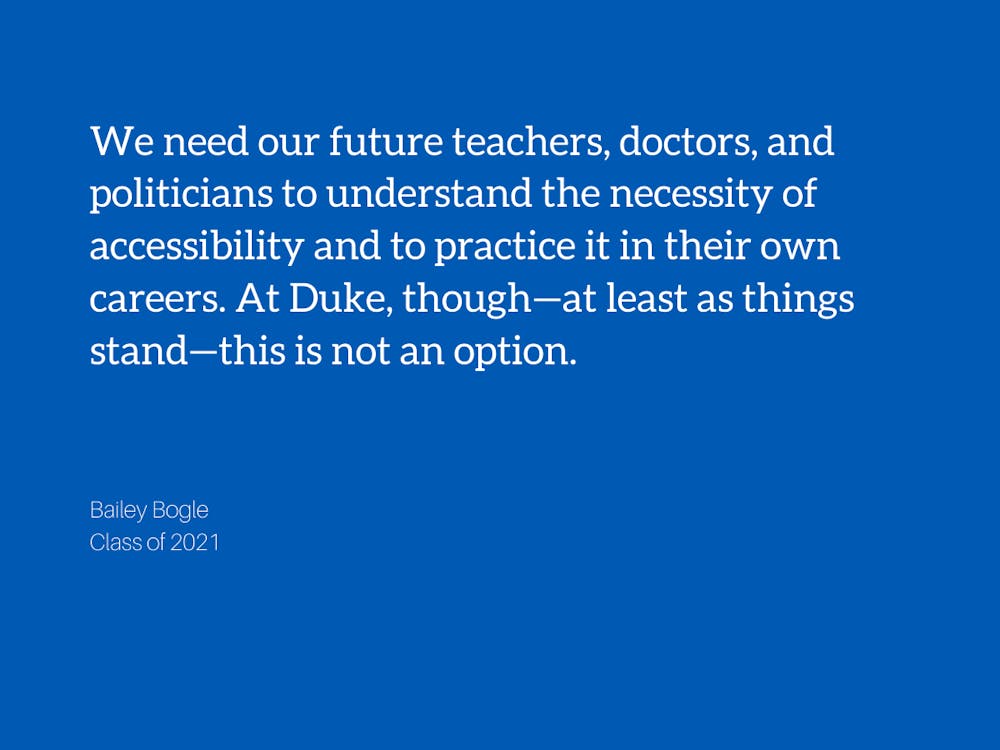When I was thirteen, I failed my hearing test. I had faced problems with my ears before—recurrent ear infections led to a childhood ear surgery, as well as some reduced hearing ability. But this time, something was different. Unbeknownst to me, what had started as a small hole in my right eardrum had become an expanding perforation that, by the time it was caught, was the size of my eardrum itself. It would end up taking two surgeries and about a year to reconstruct my eardrum, leaving me nearly half deaf in the meantime. The reconstruction was successful (though I am still hard of hearing), but this experience transformed the way I view the world.
Even at the peak of my half-deafness, I did not miss my hearing. What I did miss, however, was being a full participant in our hearing-centric society. I pretended to laugh at jokes I couldn’t hear in the cafeteria, missed out on educational videos without captions and mourned the loss of whispered middle-school gossip in the library. When taken together, these small, everyday inconveniences caused me great frustration and isolation. Accessibility is not always a consideration or priority for people to whom everything is accessible, and many of my friends and teachers, though well-meaning, didn’t always understand how to accommodate me and ensure I was included.
Being deaf or hard of hearing is not a bad thing—it’s just different. Deaf people live their lives just like hearing people do, from driving cars to enjoying music. There is also a flourishing Deaf community and culture with which many Deaf individuals strongly identify. This is why many Deaf people prefer more positive terms like “Deaf gain” to describe themselves, instead of focusing on the negative sides of disability. As I learned the hard way, though, this doesn’t mean the Deaf don’t face accessibility challenges.
The problems I’ve faced as a hard-of-hearing student are only the tip of the iceberg when it comes to accessibility issues for the Deaf. Because I can use and understand oral English, I can interact fairly easily with hearing people. Though there are some strategies the Deaf can learn to interact with oral language users, such as lip reading, speech therapy and cued speech, these are not languages in and of themselves, and they are not always effective—an experienced lip reader, for example, may still only catch 40% of what is being said, and cued speech is not widely known and used. It’s because of this that Sign Language is one of the best options for the Deaf.
In America, many Deaf people use American Sign Language, or ASL. Just like spoken languages, there are many different sign languages, and each one has its own grammatical structure, vocabulary, and regional dialects. Everyone deserves language, whether they are hearing or not, and Sign Languages allow the Deaf to fully communicate in ways spoken language often cannot.
One of the greatest barriers to accessibility for the Deaf is the lack of ASL education and cultural knowledge in the United States. Imagine boarding a plane and missing out on vital safety information, or being unable to communicate with paramedics during a medical emergency. Or, imagine being unable to communicate with a police officer who doesn’t understand your culture, needs, or language—will she know that you’re not disobeying orders, and that you need your hands to talk? These are some of the very real challenges that ASL users face, in addition to general inconveniences, social isolation, and educational or occupational barriers.
If more hearing people took ASL courses, though, things could look much different. A person who’s learned about Deaf culture may later work for a theater and advocate for inclusive performances, and a doctor who knows even basic ASL may be able to get life-saving information from her patient before the interpreter arrives. In order to change our society for the better, it’s vital that hearing people have the ability and willingness to learn about Deaf culture, accessibility, and language.
We need our future teachers, doctors, and politicians to understand the necessity of accessibility and to practice it in their own careers. At Duke, though—at least as things stand—this is not an option. We are shamefully behind when it comes to introducing American Sign Language to the curriculum, despite overwhelming student interest and the examples set by our peer schools.
In the two years since I started the Duke American Sign Language club, hundreds of students expressed interest in ASL or taken our free, weekly lessons. As a tour guide, I’ve had multiple hard-of-hearing students join my tours–and every one of them has left disappointed that Duke, unlike its peer schools like Harvard and Yale, doesn’t offer ASL education. By not offering ASL, Duke is both limiting its students and harming our school’s accessibility and reputation. If Duke wants to realize its stated values of inclusion and leadership, then the University must offer ASL education and begin to broaden the scope of its accommodations for Deaf and hard-of-hearing students on campus.
Bailey Bogle is a Trinity junior and the founder of the Duke American Sign Language Club. If you are a Duke student or faculty/staff member and you agree, please sign Duke ASL’s petition to introduce ASL courses and call on the University to do better—because quite frankly, we can.
Editor's note, 02/25/2022: This column has been updated to reflect more current language used in the Deaf community.
Get The Chronicle straight to your inbox
Sign up for our weekly newsletter. Cancel at any time.

